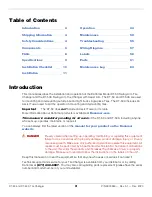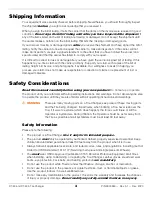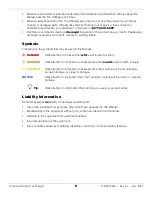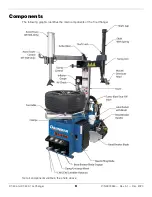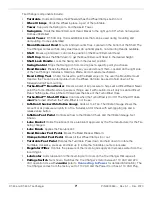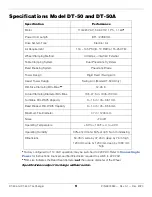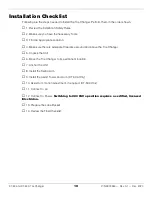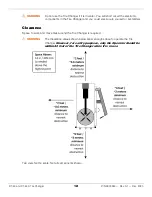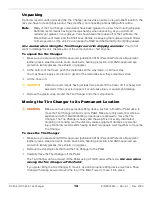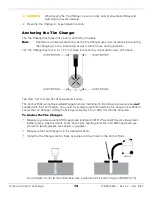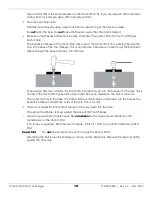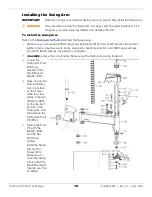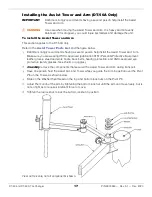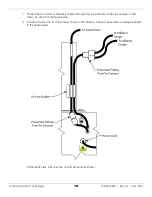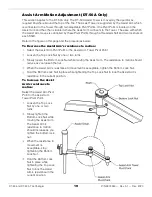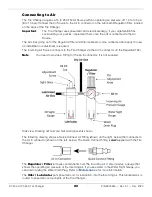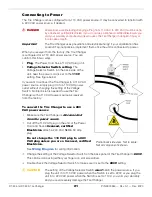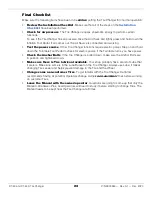
DT-50 and DT-50A Tire Changer
8
P/N 5900260 — Rev. A1 — Dec. 2020
Frequently Asked Questions
Question
: What does a Tire Changer do?
Answer
:
A Tire Changer takes Tires off of Wheels (called demounting), puts Tires onto Wheels
(called mounting), and inflates Tires.
Q
: What is the difference between a Tire, Wheel, and Rim?
A
: A Wheel is the round
metal
piece that attaches to the Vehicle’s axle. A Tire is the round
rubber
piece that surrounds the Wheel. The outer edge of the Wheel, where the Tire attaches to the
Wheel, is called the Rim. Some people use Wheel and Rim interchangeably.
Q
: What are the steps in the process of demounting a Tire and then mounting a new Tire?
A
: The steps are: Deflate the Tire, break the Bead on both sides of the Tire, secure the Wheel on the
Turntable, demount the Tire, mount the new Tire, inflate the new Tire, then remove the Wheel
from the Turntable.
Q
: What does “break the Bead” mean?
A
: A Tire is held on the Rim of a Wheel by the Tire Bead sitting between the Rim Lip and the Bead
Retainer of the Rim (this location is called the Bead Seat). The air pressure in the Tire holds it in
place once the Bead is seated (during mounting). When you “break the Bead”, you move the Tire
Bead out of Bead Seat, which is required to demount the Tire.
Q
: Can I break the Bead without fully deflating the Tire?
A
: No, do not do this.
Always fully deflate a Tire before attempting to break its Bead.
The air pressure energy in a Tire, even if not fully inflated, can be considerable. If you attempt to
break the Bead of a Tire not fully deflated, that air pressure energy would be released all at once,
possibly injuring or, in rare cases, killing the Operator or bystanders.
Q
: What important thing should I always do when working with the Tire Changer?
A
: You must identify and correctly match the Tire and Wheel/Rim diameters of the Tires you are
mounting; they must match exactly. If they do not match exactly, this is called a Tire mismatch.
The result of a mismatch is that the Tire could literally explode off the Wheel when you inflate it or
while the Vehicle is being driven. In both cases, people could be injured or killed. Note that the
phrase “Tire mismatch” is also used to mean Tires on a single Vehicle with different tread patterns
or from different manufacturers. This is not what we are talking about here. Dannmar
recommends getting and reading OSHA standard 29 CFR 1910.177 (Servicing Multi-Piece and
Single Piece Rim Wheels) for additional information.
Q
: Where should I put my Tire Changer?
A
: Place the Tire Changer on a flat Concrete Floor with clearance around it that is also near where
you work on Tires. Ideally, you want it a little off the beaten path, as you must – for safety – keep
everyone away from the Tire Changer while it is in use. No one other than the Operator should be
within 30 feet of the Tire Changer while it is in use. Refer to the
Q
: Why is there a 110 VAC plug on the Power Cord; I want to use a 220 VAC power source?
A
: The Tire Changer comes configured from the factory for 110 VAC operation. However, it may be
converted to 220 VAC. Conversion requires a certified, licensed Electrician. Refer to
for complete instructions for switching. Pay careful attention to the instructions for
switching input voltage. If done incorrectly, the Tire Changer will be damaged.
Summary of Contents for DT-50
Page 57: ...DT 50 and DT 50A Tire Changer 57 P N 5900260 Rev A1 Dec 2020 Wiring Diagram...
Page 58: ...DT 50 and DT 50A Tire Changer 58 P N 5900260 Rev A1 Dec 2020 Labels...
Page 60: ...DT 50 and DT 50A Tire Changer 60 P N 5900260 Rev A1 Dec 2020...
Page 73: ...DT 50 and DT 50A Tire Changer 73 P N 5900260 Rev A1 Dec 2020 Gearbox...
Page 83: ...DT 50 and DT 50A Tire Changer 83 P N 5900260 Rev A1 Dec 2020 Maintenance Log...
Page 84: ...1645 Lemonwood Drive Santa Paula CA 93060 USA 2020 Dannmar Inc All rights reserved Dannmar com...



